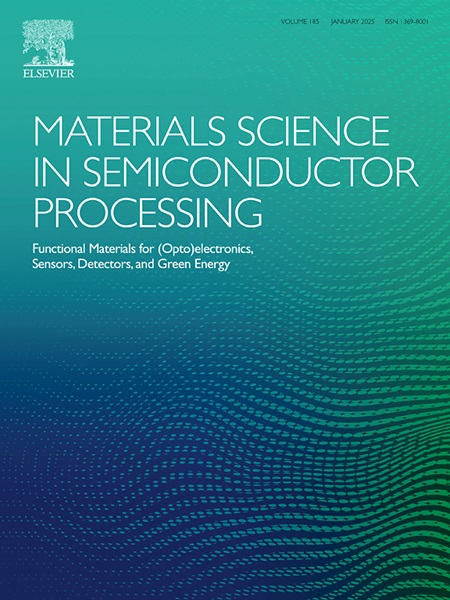Enhancing efficiency and stability of perovskite solar cells via DB24C8 dual-sided passivation at the ETL/PVSK interface
IF 4.2
3区 工程技术
Q2 ENGINEERING, ELECTRICAL & ELECTRONIC
引用次数: 0
Abstract
This study demonstrates the effectiveness of Dibenzo-24-crown-8 (DB24C8) as a passivation agent at the interface between the electron transport layer (ETL) and perovskite (PVSK) layer in perovskite solar cells (PSCs). By optimizing the surface morphology of the SnO2 in the ETL, DB24C8 reduces interfacial defects, lowers leakage current, and enhances the wettability of the ETL, resulting in improved nucleation and crystallinity of the PVSK film. Within the PVSK layer, DB24C8 increases grain size and reduces grain boundary defects and trap states, as confirmed by photoluminescence (PL) and time-resolved photoluminescence (TR-PL) measurements. Optimizing DB24C8 concentration at 3 mM raises the power conversion efficiency (PCE) from 16.72 % to 20.53 %, with improvements in open-circuit voltage (Voc), short-circuit current density (Jsc), and fill factor (FF). Furthermore, the dual-sided passivation of DB24C8 enhances the long-term stability of devices, maintaining over 80 % of initial efficiency after 1500 h under unencapsulated conditions. These findings suggest that DB24C8 significantly improves both performance and environmental stability, making it a promising candidate for the commercial application of PSCs.
在ETL/PVSK界面通过DB24C8双面钝化提高钙钛矿太阳能电池的效率和稳定性
本研究证明了二苯并-24-冠-8 (DB24C8)作为钙钛矿太阳能电池(PSCs)中电子传输层(ETL)和钙钛矿层(PVSK)界面钝化剂的有效性。DB24C8通过优化ETL中SnO2的表面形貌,减少了ETL的界面缺陷,降低了泄漏电流,提高了ETL的润湿性,从而提高了PVSK膜的成核性和结晶度。通过光致发光(PL)和时间分辨光致发光(TR-PL)测量证实,在PVSK层内,DB24C8增加了晶粒尺寸,减少了晶界缺陷和陷阱态。优化DB24C8浓度为3 mM时,功率转换效率(PCE)从16.72%提高到20.53%,开路电压(Voc)、短路电流密度(Jsc)和填充因子(FF)均有改善。此外,DB24C8的双面钝化增强了器件的长期稳定性,在无封装条件下,在1500 h后保持超过80%的初始效率。这些发现表明,DB24C8显著提高了性能和环境稳定性,使其成为PSCs商业应用的有希望的候选者。
本文章由计算机程序翻译,如有差异,请以英文原文为准。
求助全文
约1分钟内获得全文
求助全文
来源期刊

Materials Science in Semiconductor Processing
工程技术-材料科学:综合
CiteScore
8.00
自引率
4.90%
发文量
780
审稿时长
42 days
期刊介绍:
Materials Science in Semiconductor Processing provides a unique forum for the discussion of novel processing, applications and theoretical studies of functional materials and devices for (opto)electronics, sensors, detectors, biotechnology and green energy.
Each issue will aim to provide a snapshot of current insights, new achievements, breakthroughs and future trends in such diverse fields as microelectronics, energy conversion and storage, communications, biotechnology, (photo)catalysis, nano- and thin-film technology, hybrid and composite materials, chemical processing, vapor-phase deposition, device fabrication, and modelling, which are the backbone of advanced semiconductor processing and applications.
Coverage will include: advanced lithography for submicron devices; etching and related topics; ion implantation; damage evolution and related issues; plasma and thermal CVD; rapid thermal processing; advanced metallization and interconnect schemes; thin dielectric layers, oxidation; sol-gel processing; chemical bath and (electro)chemical deposition; compound semiconductor processing; new non-oxide materials and their applications; (macro)molecular and hybrid materials; molecular dynamics, ab-initio methods, Monte Carlo, etc.; new materials and processes for discrete and integrated circuits; magnetic materials and spintronics; heterostructures and quantum devices; engineering of the electrical and optical properties of semiconductors; crystal growth mechanisms; reliability, defect density, intrinsic impurities and defects.
 求助内容:
求助内容: 应助结果提醒方式:
应助结果提醒方式:


